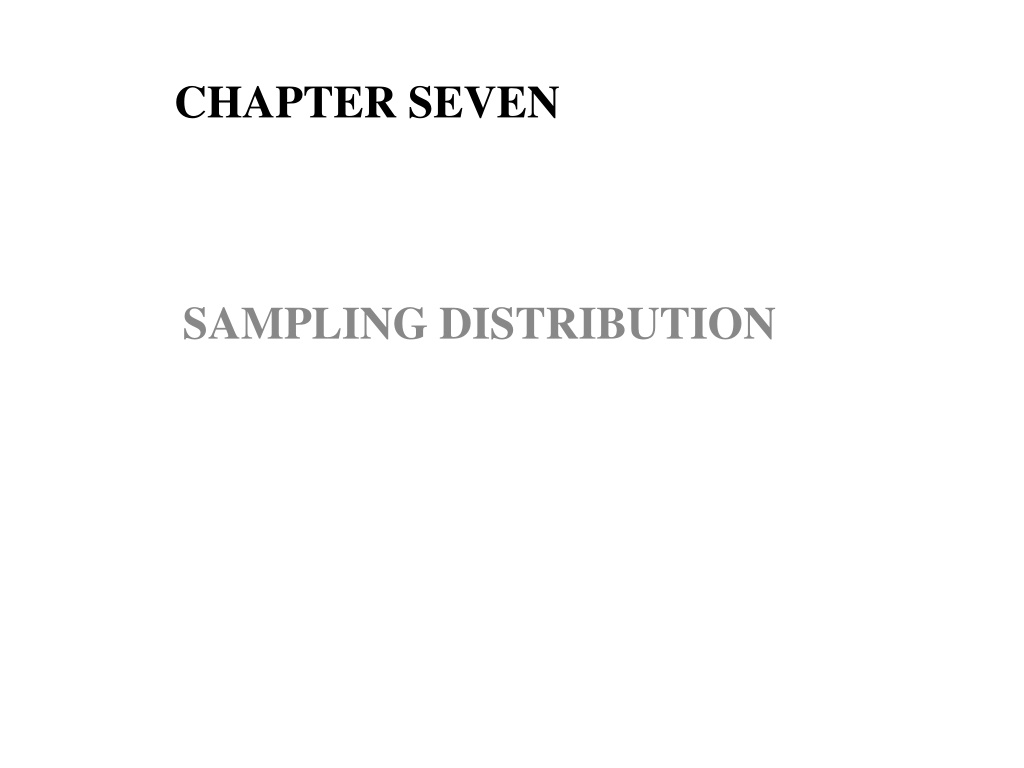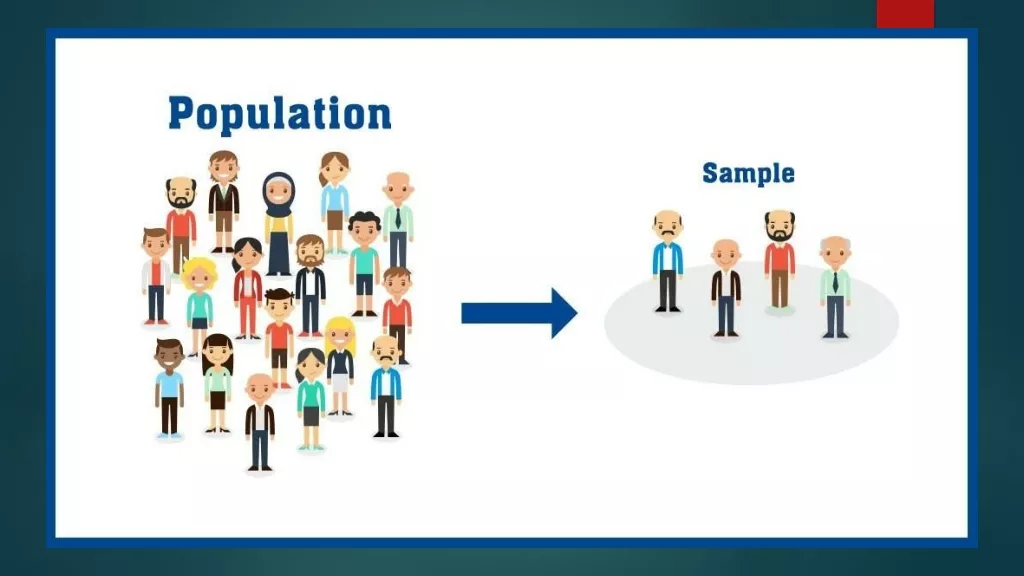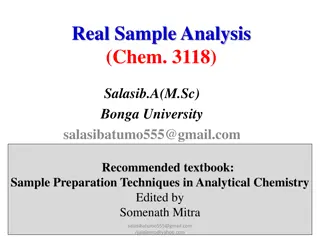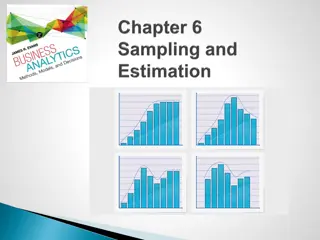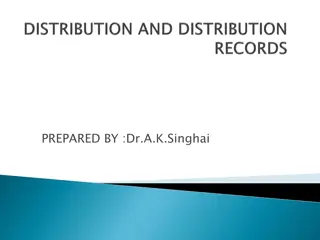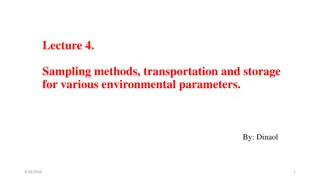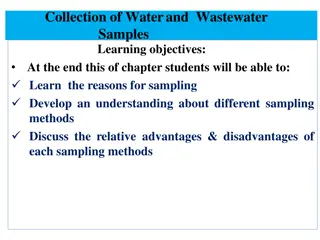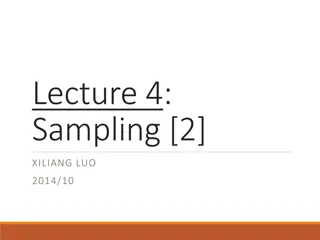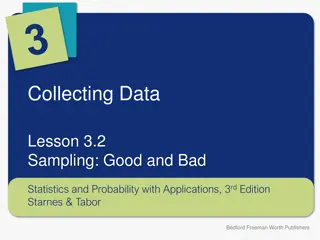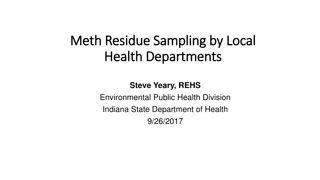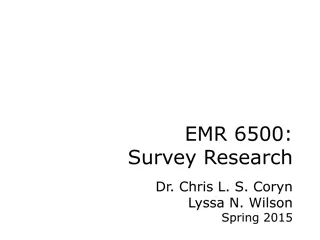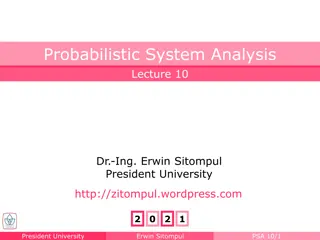Sampling Distribution and Fundamental Concepts
Population, census survey, parameter, sample, sampling frame, element, statistics, sample design, census vs. sample method, advantages and limitations of census. Understanding the key concepts and differences between census and sampling in research.
Download Presentation

Please find below an Image/Link to download the presentation.
The content on the website is provided AS IS for your information and personal use only. It may not be sold, licensed, or shared on other websites without obtaining consent from the author.If you encounter any issues during the download, it is possible that the publisher has removed the file from their server.
You are allowed to download the files provided on this website for personal or commercial use, subject to the condition that they are used lawfully. All files are the property of their respective owners.
The content on the website is provided AS IS for your information and personal use only. It may not be sold, licensed, or shared on other websites without obtaining consent from the author.
E N D
Presentation Transcript
CHAPTER SEVEN SAMPLING DISTRIBUTION
Some Fundamental concepts and Definitions Population: is the aggregation of survey elements from which the survey sample is actually selected. It is the totality of observations with which the researcher is concerned. Census survey: is the process of examining the entire population. It is the total count of the population. Parameter: is a descriptive measure (value) computed from the population. It is the population measurement used to describe the population. Example: Population mean and Population standard deviation theoretically specified
Sampling refers to the process of choosing a small number or part of a larger from the population so that some inference about the population can be made by studying the sample. Sample: a subset or some part of a larger population selected to draw conclusions about the population. Sampling Frame: is list of elements such as people, items or units from which the sample is taken. Element: is unit from which information is collected and which provides the basis of analysis Statistics: is a characteristics of a sample. It is a value computed from the sample.
Sample Design: is a definite plan for obtaining a sample frame. Sample design should answer the following: What type of sample to use? What is the appropriate sample unit? What frame (List of Sampling Unit) is available for the population?
ii. Census Vs Sample Once the population has been defined, the researcher must decide whether the survey is to be conducted among all members of the population or only a subset of the population. That is, a choice must be made between census and sample. What is the Difference between Census and Sample Method? Under the census or complete enumeration survey method, data are collected for each and every unit (person, household, field, shop, factory etc.), as the case may be of the population or universe, which is the complete set of items, which are of interest in any particular situation where as under sample survey data are collected from a small part of the population which helps to know the characteristics of the universe or population.
Advantages of Census Reliability: data derived through census are highly reliable. Detailed information: Census data yield much information as data are obtained from each and every unit of the population. Data of complete enumeration census can be widely used as a basis for various surveys. Limitation of census Expensiveness: Investigating each elements of the population is expensive to any individual researcher. Excessive time and energy: takes too long time and consumes too much energy. If the population is infinite the method cannot be adopted. beside cost factor, census survey
The Need for Sampling To solve this problem, we take a representative sample out of the population on the basis of which we draw conclusions about the entire population. Therefore, sampling survey Helps to estimate the parameter of a large population. Is cheaper, practical, and convenient. Cost involved for the study is less Time taken for the study is short Save time and energy. Easy to handle and analysis Physical impossibility of complete enumeration Practical infeasibility of complete enumeration Enough reliability of inference based on sampling
What the Essentials of Sampling? i.Representativeness: A sample should be so selected that it truly represents the universe otherwise the results obtained may be misleading. ii. Adequacy: The size of sample should be adequate; otherwise it may not represent the characteristics of the universe. iii. Independence: All items of the sample should be selected independently of one another and all items of the universe should have the same chance of being selected in the sample. iv. Homogeneity: When we talk of homogeneity we mean that there is no basic difference in the nature of units of the universe and that of the sample. If two samples from the same universe are taken, they should give more or less the same unit.
Limitations of sampling Less Accuracy: in comparison to census technique the conclusion derived from sample are more liable to error. Therefore, sampling techniques is less accurate than the census technique. Misleading conclusion: If the sample is not carefully selected or if samples are arbitrarily selected, the conclusion derived from them will become misleading if extended to all population. Need for specialized knowledge: the sample technique can be successful only if a competent and able scientist makes the selection.
Sampling technique is used under the following conditions Vast Data: When the number of units is very large, sampling technique must be used. B/c it economize money, time and effort. When utmost accuracy is not required: The sampling technique is very suitable in those situations where 100% accuracy is not required, otherwise census technique is unavoidable. Infinite population: if the population is unlimited, sampling technique is imminent. When census is impossible: if we want to know the amount of mineral wealth in a country we cannot dig all mines to discover and count. Rather we have to use the sampling technique. Homogeneity: if all units of the population are alike (similar) sampling technique is easy to use.
7.1. Sampling Techniques They are basically of two types: non-probability sampling and probability sampling. 1. Non- probability sampling The non-probability sampling is much less complicated & less expensive. It is very convenient in situations when the sample to be selected is very small & the researcher wants to generalize some idea of the problem using well-informed member in a short time. The non-probability sample may prove perfectly adequate if the researcher has no desire to generalize his findings beyond the sample.
There are five types of non-probability sampling Convenience sampling: unrestricted are called convenience samples or accidents sample. In this sample, the investigator chooses the closest live persons as respondents. Quota Sampling: it is non-probability sampling, which is equivalent to stratified sampling with added requirement that each stratum is generally represented in the sample in the same proportion as in the same population. sampling is impractical to use because of difficulty of getting complete list of the units in the strata of the population, quota sampling becomes appropriate. Dimensional sampling: it is basically a multi dimensional form of quota sampling. The idea is to specify all dimensions/ variables/ of interest in the population to make sure that every combination of these dimensions is represented by at least one case. Non-probability samples that are When stratified random
Purposive Sampling: in purposive or judgmental sampling the investigator doesn t necessary have a quota to fill from within various strata as in quota sampling, but neither does he just pick the nearest bodies as in convenience sampling. The researcher uses his own judgment about which respondent to choose and pick only those who best meet the purposes of the study. Snow Balling Sampling: the term snowball comes from the analogy of snowball, begins small but becomes bigger and bigger as it rolls down hill.
This method of sampling is conducted in stages. In the first stage a few persons having the requisite characteristics are identified and interviewed. The second stage involves interviewing these persons who in turn lead to still more persons who can be interviewed in the third stage, and so on. II. Probability Sampling It implies that the probability of selection of each respondent is known. The different sampling methods of probability sampling include:
1 .Simple Random Sampling: each member of the population understudy has an equal chance of being selected. The method involves selecting at random from al list of the population (sample frame) the required number of subjects for the sample. 2. Systematic sampling: this method is the modified form of simple random sampling. It involves selecting from population lists in a systematic random fashion. For example, from a population of 2000 a sample of 200 is required and then every 10thperson can be selected. The starting point for the selection is chosen at random.
3. Stratified Sampling: it involves dividing the population in to homogonous groups, each group containing subjects with similar characteristics. For example, group A might contain males and group B females. In order to obtain a sample representative of the whole population in terms of sex, random sampling selection of subjects from groupAand group B must be taken.
4. Cluster sampling: It is used when the population under study is large, when the distribution of the members is scattered, or when the selection of individual members is not continent for several reasons. Cluster sampling is used in situations where the population members are naturally grouped in unit that can be used conveniently as clusters. Example :A researcher is interested to survey the Math s achievement of 4th grade students in elementary schools found in Ethiopia. It is practically impossible to test all 4thgrade students in elementary school students in the country by a single researcher. Since the 4thgraders are naturally grouped by regions, Zones, Woredas, schools and classes, the researcher may take zones or Woredas or schools as clusters.
Cluster sampling differs from stratified random sampling in that in cluster sampling random selection occurs not with the individual members but with the clusters. 5. Stage (multi stage) Sampling The researcher may have to use two, there, or four stage sampling. For example, a researcher wants to study the opinion of teachers towards self-centered class system. He wants to select a sample from all elementary school teachers in Ethiopia.
A simple random sampling would be impractical and so from the regional state a sample of five regional states could be selected randomly from Northern, Eastern, southern, Western and central regions. From the five states chosen, all zones could be listed and random sample of 15 zones selected. Form the 15 zones, 30 Woredas can be selected randomly and from these Woredas all elementary schools could be listed and a random sample of 100 schools selected. It wouldn t be difficult to compile a list of all elementary school teachers working in 100 schools and random sample of say 650 teachers selected.
7.2.Sampling Distributions 7.2.1.Sampling Distributions of Sample Mean It is a theoretical probability distribution that shows the functional relation ship b/n the possible values of a given sample mean based on samples of n size and the probability associated with each value, for all possible samples of size drawn from that particular population. There are n commonly three properties of interest of a given sampling distribution. Its Mean Its Variance Its Functional form.
Steps for the construction of Sampling Distribution of the mean 1. From a finite population of size N, randomly draw all possible samples of size n 2. Calculate the mean for each sample. 3. Summarize the mean obtained in step 2 in terms of frequency distribution or relative frequency distribution. Example: Suppose we have a population of size age of five children: 6, 8, 10, 12, and 14. Take samples of size 2 with replacement and construct sampling distribution of the sample mean. solution: We have possible samples since sampling is with replacement. Step 1: Draw all possible samples: , consisting of the = 5 N = = , 5 2 N n 52= n = 25 N
6 8 10 12 14 6 8 (6, 6) (8,6) (10,6) (12,6) (12,6) (6, 8) (8,8) (10,8) (12,8) (14,8) (6, 10) (8,10) (10,10) (12,10) (12,10) (6, 12) (8,12) (10,12) (12,12) (12,12) (6, 14) (8,14) (10,14) (12,14) (12,14) 10 12 14 Step 2: Calculate the mean for each sample: 6 6 7 8 9 8 7 8 9 10 8 9 10 11 12 12 9 10 11 12 13 14 10 11 12 13 14 6 8 10 12 14 10 11 10 Step 3: Summarize the mean obtained in step 2 in terms of frequency distribution.
X say Frequency , X A, Find the mean of X 6 7 8 9 1 2 3 4 5 4 3 2 1 250 X f = = = = i f i 10 X 25 i B, Find the variance of , say 2 X 10 11 12 13 14 X 2 f ( ) X f 100 2 2 = = = i i X 4 X 25 i Remark: 1. In general if sampling is with replacement = 2 2 X n 2 N n 2. If sampling is with out replacement 2 = X 1 n N
3. In any case the sample mean is unbiased estimator of the population mean. i.e. = = ) (X E X Sampling may be from a normally distributed population or from a non-normally distributed population. When sampling is from a normally distributed population, the distribution of will posses the following property. 1. The distribution of will be normal 2. The mean of is equal to the population mean , i.e. 3. The variance of is equal to the population variance divided by the sample size, i. e 2 2 = ~ n X X X = X X 2 ~ ( , ) X N n X = ) 1 , 0 ( N Z X n
Central Limit Theore Given a population of any functional form with mean variance , the sampling distribution of , computed from samples of size n from the population will be approximately normally distributed with mean and variance , when the sample size is large. n and finite 2 X 2
